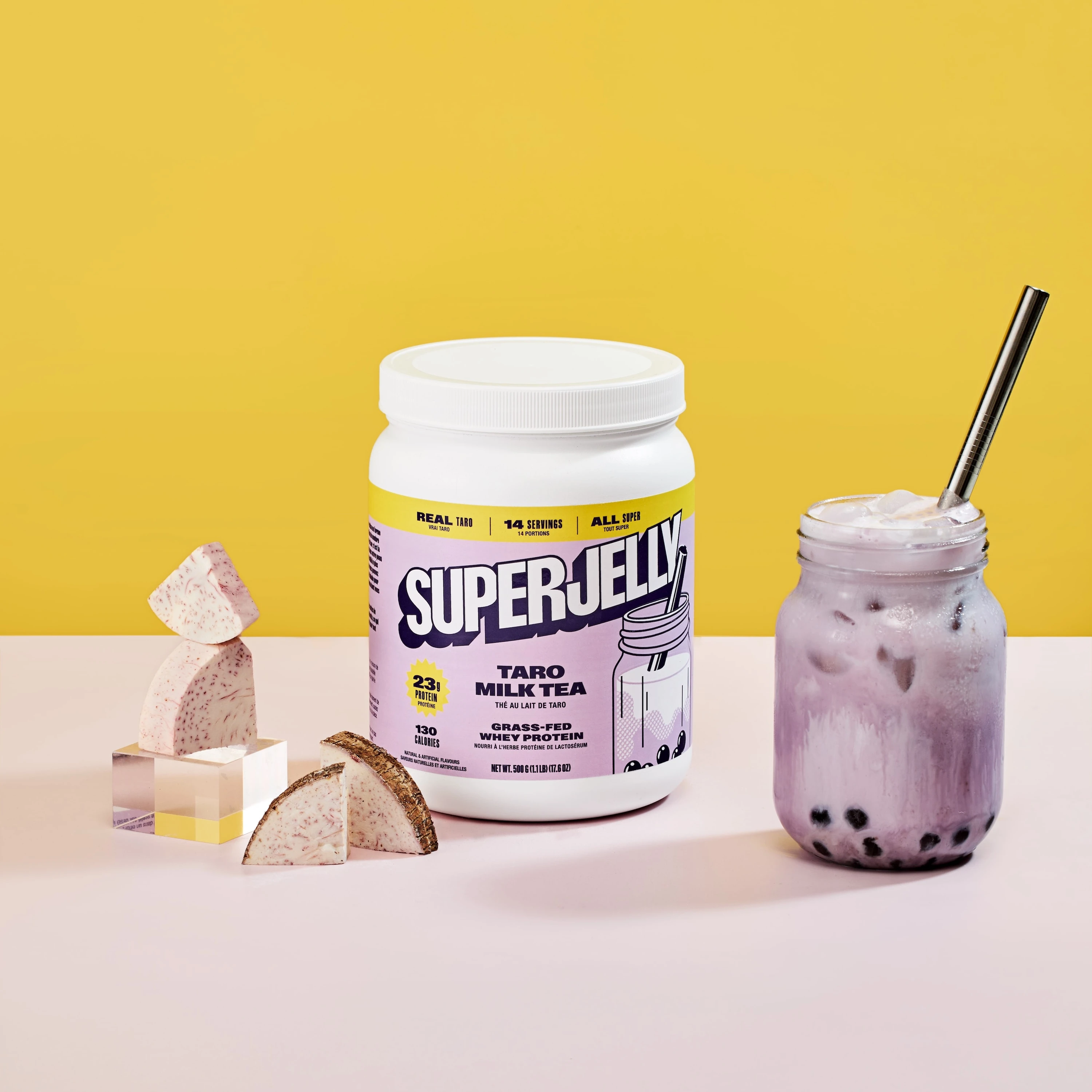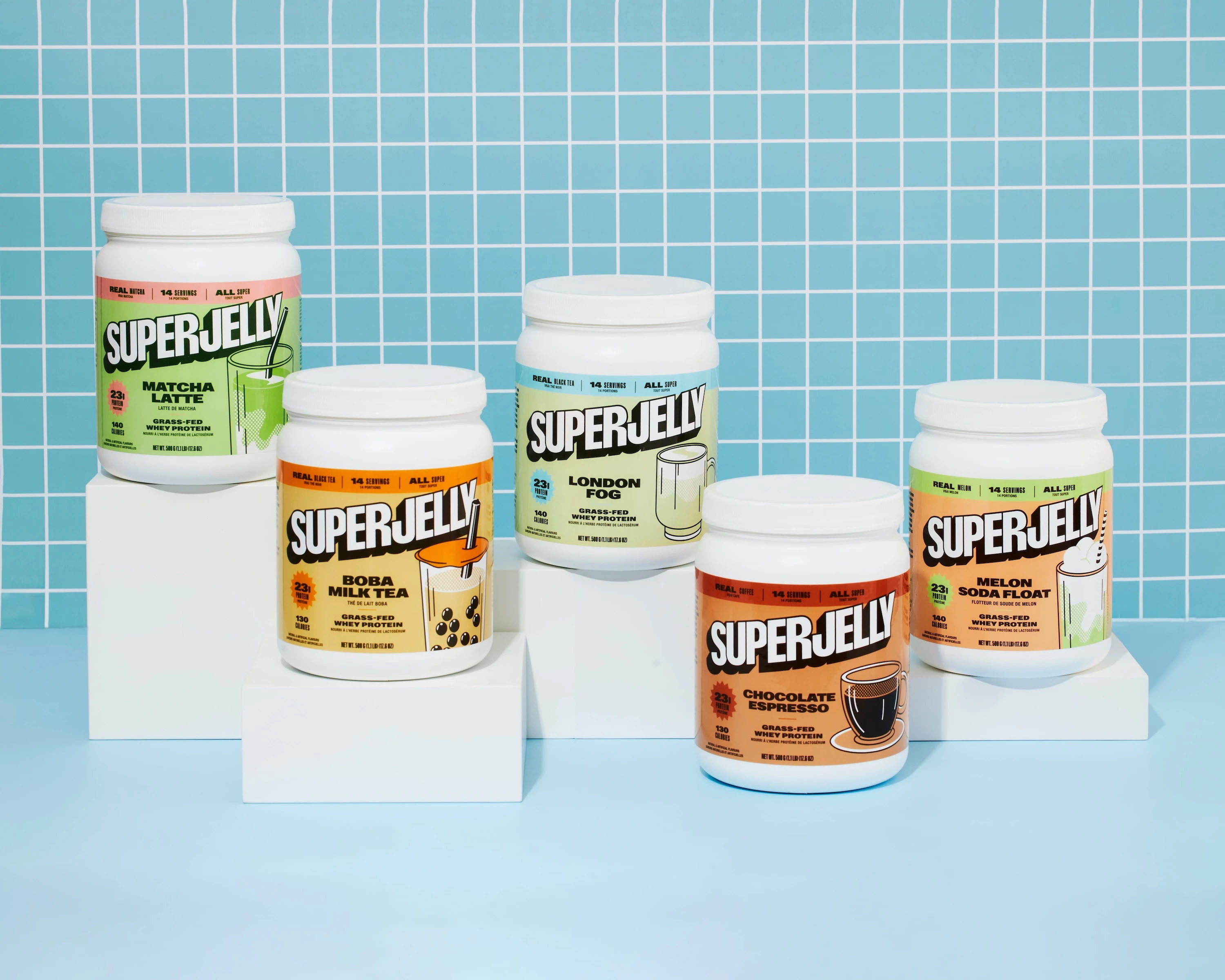The Challenge:
When Generic Product Shots Undermine Premium Supplement Positioning
When Superjelly launched in January 2023, the British Columbia-based nutrition company entered a supplement market where most brands still lean on chalky protein powders in bland packaging and uninspired imagery. Their mission, "keep your cravings," promised something different: whey isolates and vegan blends in flavors like Melon Soda Float, Matcha Latte, and Taro Milk Tea, all with low sugar and transparent labeling. But the visual gap between that promise and the generic product shots flooding Instagram and Amazon threatened to bury the brand before it gained traction.
Marketing directors at emerging DTC supplement brands face a recurring problem: generic product photography communicates function but fails to capture the indulgent, lifestyle-driven appeal that converts fitness-minded consumers who also want flavor. For Superjelly, the challenge was acute. Their flavor-first positioning demanded imagery that could compete with dessert brands and bubble tea shops on social feeds while still signaling performance, clean ingredients, and premium Canadian manufacturing. Standard e-commerce photography, white backgrounds and centered bottles, would position them as just another supplement company, not the playful, credible alternative they set out to be.
The business stakes were clear. Direct-to-consumer supplement brands live or die on scroll-stopping visuals that drive click-through rates and time on page. When leadership approved an average product price point of thirty to thirty-five dollars, they created pressure to justify premium positioning through every customer touchpoint. If the photography felt generic or inconsistent, conversion rates would sag and social engagement would stall, no matter how innovative the formulations.
The brand needed a visual system that could scale across flavor SKUs, maintain label legibility on mobile devices, and translate the sensory experience of indulgent taste into static images. Without it, Superjelly risked becoming invisible in a crowded feed, indistinguishable from the dozens of other supplement brands competing for the same fitness-oriented audience.
The Strategy:
Building a Repeatable Visual Language for Flavor-First Supplements
The solution required a photographer who understood that lifestyle photography for supplement brands is not about documenting products but about constructing a repeatable visual language that balances performance credibility with culinary appeal. The approach started with a rules-based system built around flavor-keyed color strategy, modular pattern grids, and texture-forward macro details that could anchor campaigns across platforms.
Instead of treating each SKU as a standalone shoot, the plan centered on creating a structured asset library: pattern heroes, flavor vignettes, and group compositions that would give the marketing team flexibility to execute social campaigns, paid ads, and product detail pages without starting from scratch every time they introduced a new flavor. The color-complementary product photography framework became the backbone of the system.
Each flavor received a background palette engineered for maximum chroma separation: yellow against purple for energy, green against pink for plant-based freshness, saturated blues for cooling flavors. This was not arbitrary aesthetics. Complementary pairings boost brand recall by creating high-contrast memory anchors, making it easier for a consumer scrolling through a feed to recognize Superjelly in a fraction of a second.
The photographer mapped each flavor to a specific color identity and locked in lighting ratios that would remain consistent across future shoots, ensuring that a London Fog shot captured in one session would sit seamlessly next to a Matcha Latte shot from another. The goal was to build visual equity, where every new image reinforced the system rather than fragmenting it.
Multi-Flavor Pattern Grids as Scalable Execution Engine
Multi-flavor pattern grid photography turned that equity into a scalable execution engine. Using overhead and slight-angled modular compositions, the photographer created pattern layouts where bottles, scoops, and ingredient props repeated in disciplined grids. The technique delivered two advantages.
First, it gave the brand a hero image that communicated variety and premium quality in a single frame, ideal for homepage banners and print collateral. Second, the modular structure allowed the marketing team to crop individual sections for single-SKU ads or carousel posts without losing coherence. Instead of commissioning separate hero shots for every flavor launch, Superjelly could extract assets from a master pattern and maintain consistency.
The photographer used risers and tiled set design to create clean hierarchy within the pattern, ensuring that each bottle remained distinct while contributing to the overall composition. Supplement product photography label legibility became a non-negotiable technical requirement. Leadership knew that unclear labels on mobile screens hurt conversion rates and can trigger ad disapprovals on platforms that require visible ingredient claims.
The photographer deployed high-key, even illumination with controlled soft shadowing, spacing the light sources to eliminate hotspots on glossy packaging while keeping typography tack-sharp. Before finalizing the lighting setup, the team ran mobile crop tests at 320 to 390 pixel widths, the dimensions where most users first encounter product detail pages and Instagram ads. Any label element that blurred or lost contrast at that size triggered adjustments to the lighting or camera angle.
The Execution:
Macro Texture Photography as Trust Signal
Macro texture supplement photography addressed the challenge of making "clean formulations" and bold flavors feel tangible. Superjelly's value proposition rests on simple ingredient lists and third-party testing, but those claims are abstract until a consumer can see the product. The photographer used macro lenses and shallow depth of field to capture powder granules, mix-in details, and foam textures, often pairing them with culinary props like matcha powder spills or tapioca pearls to reinforce the flavor story.
These texture shots served as secondary assets: cutaway details for social posts, close-up insets for product pages, and proof points for email campaigns emphasizing ingredient transparency. By showing what the product looks like up close, the imagery elevated perceived quality and gave the marketing team visual shorthand for "real ingredients, no fillers."
The execution phase centered on building a launch-ready deliverables package mapped to specific channels. The photographer delivered multi-colorway pattern heroes optimized for homepage banners and paid social, flavor lifestyle scenes that positioned each SKU as a distinct experience, and structured group compositions for print and point-of-sale displays.
Each image came with crop variants pre-formatted for Instagram square, Instagram story, Facebook ad ratios, and standard PDP dimensions, eliminating the guesswork for the design team. The pattern grids included both full-frame masters and pre-cropped single-SKU extractions, giving the brand the flexibility to scale campaigns without commissioning new photography every time they needed an asset. The Vancouver supplement product photographer brought local production control and faster turnarounds, critical for a Canadian-made brand that wanted to maintain supply chain transparency and respond quickly to flavor drops or seasonal promotions.
The Results:
Visual System That Scales With Brand Growth
Superjelly received a cohesive visual system that communicated both indulgence and performance, structured to scale as the brand grew. The multi-flavor pattern grids became hero images across the website and social channels, driving measurable improvements in time on page as consumers explored the variety and premium aesthetic.
The flavor vignettes gave the marketing team the ability to launch new SKUs with scroll-stopping visuals that immediately connected taste cues to product claims, supporting the brand's strategy of occupying the space between performance supplements and food-like experiences. The macro texture shots provided proof points that reinforced the "clean ingredients" messaging, turning abstract claims into tangible visual evidence.
Label legibility improvements contributed to higher ad approval rates and reduced friction on product detail pages, where unclear packaging had previously created hesitation at the point of conversion. For marketing directors evaluating lifestyle photography for supplement brands, the Superjelly case demonstrates that a strategic visual system, built around repeatable techniques, platform-specific deliverables, and brand-aligned color strategy, delivers outcomes that generic product shots cannot.
When your brand's differentiation depends on communicating both performance and indulgence, the photography must do more than document. It must construct a visual language that makes every flavor launch feel consistent yet distinct, every product claim feel credible yet exciting, and every consumer touchpoint feel premium without feeling inaccessible. If your current creative assets feel misaligned with your brand narrative or inconsistent across flavor lines, the solution starts with a photographer who understands that supplement photography is brand storytelling, not just product documentation.
<script type="application/ld+json">
{
"@context": "https://schema.org",
"@type": "Service",
"name": "Flavor-First Lifestyle Photography for Supplement Brands with Multi-Flavor Pattern Grid Systems",
"description": "Strategic visual systems combining color-complementary backgrounds, modular pattern grids, and macro texture photography to position premium supplement brands through repeatable, platform-optimized asset libraries that maintain label legibility and scale across flavor SKUs.",
"serviceType": "Lifestyle Photography for Supplement Brands",
"provider": {
"@type": "Organization",
"name": "Elina Kustlyvy Photography",
"url": "https://www.elinakustlyvy.com"
},
"areaServed": [
{"@type": "City", "name": "Vancouver", "addressRegion": "BC", "addressCountry": "CA"},
{"@type": "City", "name": "Toronto", "addressRegion": "ON", "addressCountry": "CA"},
{"@type": "City", "name": "Los Angeles", "addressRegion": "CA", "addressCountry": "US"},
{"@type": "City", "name": "Seattle", "addressRegion": "WA", "addressCountry": "US"}
],
"url": "https://www.elinakustlyvy.com/projects/superjellyco"
}
</script>
<script type="application/ld+json">
{
"@context": "https://schema.org",
"@type": "ImageObject",
"contentUrl": "https://cdn.prod.website-files.com/653c048c7bdcdc4c8f4346aa/688e76e8f9fd90a2a838881a_68787feb9f03ec4301f8ac8e_L-Taro-Milk-Tea-pattern.webp",
"url": "https://cdn.prod.website-files.com/653c048c7bdcdc4c8f4346aa/688e76e8f9fd90a2a838881a_68787feb9f03ec4301f8ac8e_L-Taro-Milk-Tea-pattern.webp",
"name": "Superjelly Taro Milk Tea Multi-Flavor Pattern Grid with Color-Complementary Purple Background",
"caption": "Overhead modular pattern grid showcasing Superjelly Taro Milk Tea protein powder with complementary purple background, repeating bottle placement, and ingredient props creating visual hierarchy for DTC supplement brand marketing.",
"creator": {
"@type": "Person",
"name": "Elina Kustlyvy",
"url": "https://www.elinakustlyvy.com"
},
"copyrightHolder": {
"@type": "Organization",
"name": "Elina Kustlyvy Photography"
},
"acquireLicensePage": "https://www.elinakustlyvy.com/contact"
}
</script>
<script type="application/ld+json">
{
"@context": "https://schema.org",
"@type": "Brand",
"name": "Superjelly",
"description": "Canadian-based sports nutrition brand offering low-sugar, flavor-driven whey isolate and vegan protein supplements in inventive flavors like Melon Soda Float, Matcha Latte, and Taro Milk Tea, emphasizing clean formulations and Canadian manufacturing.",
"url": "https://www.superjellyco.com",
"sameAs": []
}
</script>
<script type="application/ld+json">
{
"@context": "https://schema.org",
"@type": "Product",
"name": "Superjelly Taro Milk Tea Protein Powder",
"description": "Flavor-first whey isolate protein powder in Taro Milk Tea flavor with low sugar, clean ingredient list, and third-party testing from British Columbia-based Superjelly Nutrition.",
"brand": {
"@type": "Brand",
"name": "Superjelly"
},
"category": "Sports Nutrition Protein Powder",
"review": {
"@type": "Review",
"author": {
"@type": "Person",
"name": "Elina Kustlyvy"
},
"reviewRating": {
"@type": "Rating",
"ratingValue": "5",
"bestRating": "5"
},
"reviewBody": "The powder exhibits fine, consistent granulation with no visible clumping, photographing with excellent texture separation under macro lenses. Packaging features high-contrast label typography that maintains crisp legibility even at mobile crop dimensions, with glossy finish responding well to controlled soft shadowing techniques."
}
}
</script>
<script type="application/ld+json">
{
"@context": "https://schema.org",
"@type": "BreadcrumbList",
"itemListElement": [
{
"@type": "ListItem",
"position": 1,
"name": "Projects",
"item": "https://www.elinakustlyvy.com/projects"
},
{
"@type": "ListItem",
"position": 2,
"name": "Food Photography",
"item": "https://www.elinakustlyvy.com/projects/food-photography"
},
{
"@type": "ListItem",
"position": 3,
"name": "Lifestyle Photography for Supplement Brands: Superjelly Case Study",
"item": "https://www.elinakustlyvy.com/projects/superjellyco"
}
]
}
</script>
<script type="application/ld+json">
{
"@context": "https://schema.org",
"@type": "WebPage",
"name": "Lifestyle Photography for Supplement Brands: Superjelly Case Study",
"description": "How flavor-keyed color strategy, multi-flavor pattern grids, and macro texture photography built a scalable visual system for Superjelly's premium DTC supplement brand, delivering platform-optimized assets with mobile-legible labels and measurable engagement improvements.",
"url": "https://www.elinakustlyvy.com/projects/superjellyco",
"speakable": {
"@type": "SpeakableSpecification",
"cssSelector": [".article-intro", ".article-conclusion"]
},
"about": [
{"@type": "Thing", "name": "Lifestyle Photography for Supplement Brands"},
{"@type": "Thing", "name": "Multi-Flavor Pattern Grid Photography"},
{"@type": "Thing", "name": "Color-Complementary Product Photography"},
{"@type": "Thing", "name": "Macro Texture Supplement Photography"}
],
"mentions": [
{
"@type": "Brand",
"name": "Superjelly",
"sameAs": "https://www.superjellyco.com"
},
{
"@type": "Thing",
"name": "Superjelly Taro Milk Tea Protein Powder"
},
{
"@type": "Thing",
"name": "Superjelly Matcha Latte Protein Powder"
},
{
"@type": "Thing",
"name": "Superjelly London Fog Protein Powder"
},
{
"@type": "Thing",
"name": "Superjelly Melon Soda Float Protein Powder"
}
]
}
</script>
<script type="application/ld+json">
{
"@context": "https://schema.org",
"@type": "HowTo",
"name": "How to Build a Scalable Multi-Flavor Visual System for Supplement Brands Using Pattern Grid Photography",
"description": "A structured approach combining color-complementary backgrounds, modular pattern grids, and macro texture techniques to create a repeatable asset library that maintains brand consistency across flavor SKUs while optimizing for mobile label legibility and platform-specific deliverables.",
"step": [
{
"@type": "HowToStep",
"position": 1,
"name": "Establish Color-Complementary Framework for Each Flavor SKU",
"text": "Map each flavor to a specific complementary color pairing designed for maximum color separation—yellow against purple for energy flavors, green against pink for plant-based freshness, saturated blues for cooling profiles. Lock in consistent lighting ratios across sessions so assets from different shoots sit seamlessly together, building visual equity where every new image reinforces the system rather than fragmenting it."
},
{
"@type": "HowToStep",
"position": 2,
"name": "Create Modular Pattern Grids with Overhead and Angled Compositions",
"text": "Use overhead and slightly angled modular layouts where bottles, scoops, and ingredient props repeat in clean grids, employing risers and tiled set design to create clear hierarchy. This technique delivers both a hero image communicating variety and premium quality in a single frame, plus the ability to crop individual sections for single-SKU ads or carousel posts without losing coherence, building an asset library that scales without commissioning separate shoots."
},
{
"@type": "HowToStep",
"position": 3,
"name": "Optimize Label Legibility Through High-Key Even Illumination and Mobile Crop Testing",
"text": "Set up high-key, even illumination with controlled soft shadowing, spacing light sources to eliminate hotspots on glossy packaging while keeping typography sharp. Run mobile crop tests at 320 to 390 pixel widths before finalizing, ensuring dosage information, flavor callouts, and ingredient highlights remain crisp when consumers encounter product pages and Instagram ads on small phone screens, reducing ad disapprovals and conversion friction."
},
{
"@type": "HowToStep",
"position": 4,
"name": "Capture Macro Texture Details to Make Clean Formulations Tangible",
"text": "Use macro lenses and shallow depth of field to capture powder granules, mix-in details, and foam textures, pairing them with culinary props like matcha powder spills or tapioca pearls to reinforce flavor stories. These texture shots serve as secondary assets—cutaway details for social posts, close-up insets for product pages, and proof points for email campaigns emphasizing ingredient transparency—elevating perceived quality and giving marketing teams visual shorthand for real ingredients with no fillers."
}
]
}
</script>
<script type="application/ld+json">
{
"@context": "https://schema.org",
"@type": "FAQPage",
"mainEntity": [
{
"@type": "Question",
"name": "How do you make supplement packaging labels legible in product photos for mobile ads and product pages?",
"acceptedAnswer": {
"@type": "Answer",
"text": "Label legibility requires high-key, even illumination with controlled soft shadowing, spacing light sources to eliminate hotspots on glossy packaging while keeping typography sharp. Before finalizing lighting setups, run mobile crop tests at 320 to 390 pixel widths—the dimensions where most users first encounter product pages and Instagram ads—to ensure dosage information, flavor callouts, and ingredient highlights remain crisp. Any label element that blurs or loses contrast at that size triggers adjustments to lighting or camera angle, delivering images where claims stay clear even when consumers zoom in on small phone screens."
}
},
{
"@type": "Question",
"name": "What is multi-flavor pattern grid photography and how does it help supplement brands scale campaigns?",
"acceptedAnswer": {
"@type": "Answer",
"text": "Multi-flavor pattern grid photography uses overhead and slightly angled modular compositions where bottles, scoops, and ingredient props repeat in clean grids with risers and tiled set design creating clear hierarchy. This technique delivers a hero image that communicates variety and premium quality in a single frame for homepage banners and print collateral, while the modular structure allows marketing teams to crop individual sections for single-SKU ads or carousel posts without losing coherence. Instead of commissioning separate hero shots for every flavor launch, brands can extract assets from a master pattern and maintain consistency, building an asset library that scales campaigns without starting from scratch."
}
},
{
"@type": "Question",
"name": "How does color-complementary product photography boost brand recall for supplement brands?",
"acceptedAnswer": {
"@type": "Answer",
"text": "Color-complementary product photography maps each flavor to a specific background palette designed for maximum color separation—yellow against purple for energy, green against pink for plant-based freshness, saturated blues for cooling flavors. Complementary pairings boost brand recall by creating high-contrast memory anchors, making it easier for consumers scrolling through feeds to recognize the brand in a fraction of a second. By locking in consistent lighting ratios across sessions, each flavor maintains a distinct color identity while reinforcing a unified visual system, ensuring that new images strengthen recognition rather than fragmenting it."
}
}
]
}
</script>






29972.webp)
29785.webp)






